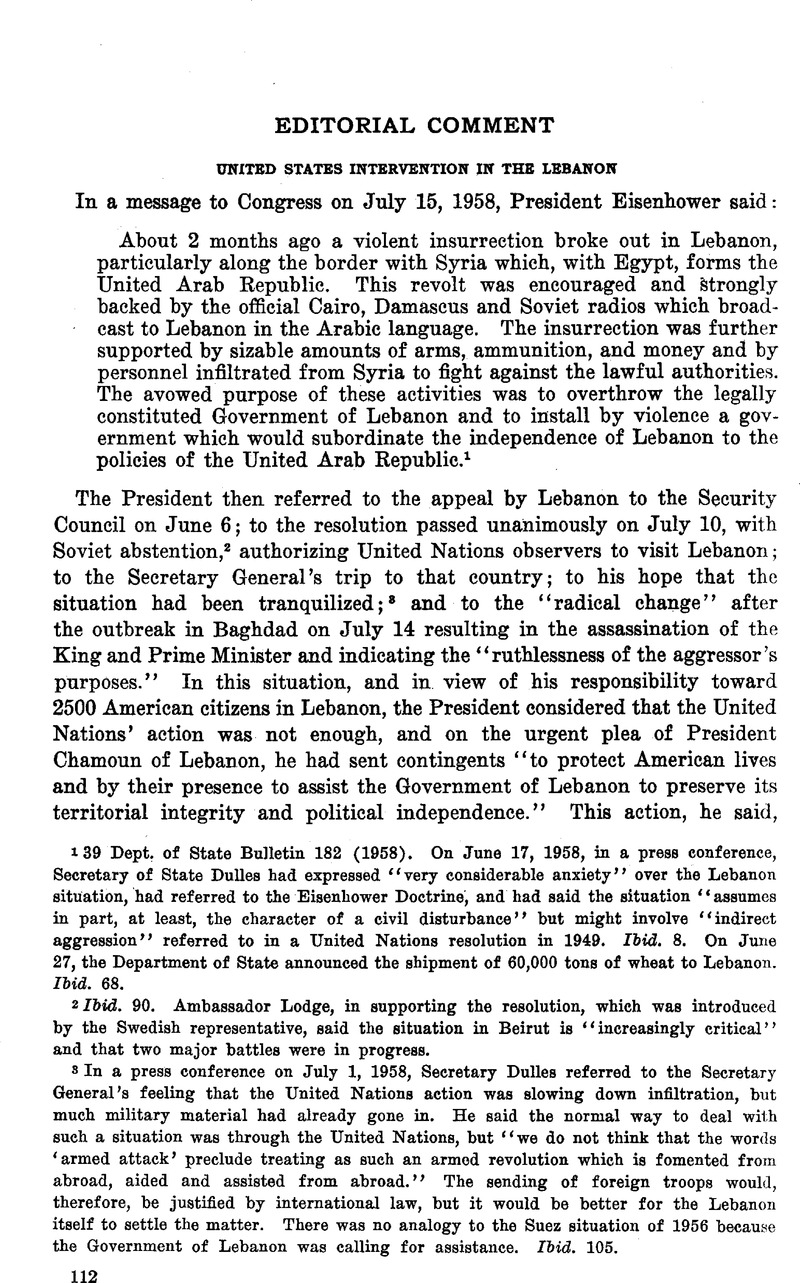Published online by Cambridge University Press: 28 March 2017

1 39 Dept. of State Bulletin 182 (1958). On June 17, 1958, in a press conference, Secretary of State Dulles had expressed “very considerable anxiety” over the Lebanon situation, had referred to the Eisenhower Doctrine, and had said the situation ‘ ‘ assumes in part, at least, the character of a civil disturbance” but might involve “indirect aggression” referred to in a United Nations resolution in 1949. Ibid. 8. On June 27, the Department of State announced the shipment of 60,000 tons of wheat to Lebanon. Ibid. 68.
2 Ibid. 90. Ambassador Lodge, in supporting the resolution, which was introduced by the Swedish representative, said the situation in Beirut is “increasingly critical“ and that two major battles were in progress.
3 In a press conference on July 1, 1958, Secretary Dulles referred to the Secretary General's feeling that the United Nations action was slowing down infiltration, but much military material had already gone in. He said the normal way to deal with such a situation was through the United Nations, but “we do not think that the words 'armed attack’ preclude treating as such an armed revolution which is fomented from abroad, aided and assisted from abroad.” The sending of foreign troops would, therefore, be justified by international law, but it would be better for the Lebanon itself to settle the matter. There was no analogy to the Suez situation of 1956 because the Government of Lebanon was calling for assistance. Ibid. 105.
4 ibid. 183-185.
5 Ibid. 192-198.
6 Ibid,. 2,67-212. He also said he was against a definition of aggression, as was British Foreign Secretary Eden at the San Francisco Conference of 1945.
7 ibid. 273.
8 ibid. 342.
9 ibid. 337-341.
10 ibid 412.
11 Ibid. 526.
12 Ibid. 604.
13 Ibid. 650.
14 ibid. 811.
15 Art. 2, par. 4.
16 Art. 51.
17 Art. 2, par. 5; Art. 11, par. 2; Art. 42; Art. 48.
18 Art. 2, par. 1.
19 Wright, Q., “The Prevention of Aggression,” 50 A.J.I.L. 526 (1956).Google Scholar
20 Art. 2, par. 3.
21 Wright, Q., “Intervention, 1956,” 51 A.J.I.L. 269, 273 (1957).Google Scholar
22 Aggression must be determined, not by the facts as they are subsequently discovered, but as the actor could reasonably interpret them with the data at his disposal. See Lytton Commission Report on Manchuria, 1932.
23 Art. 51.
24 2 Moore, Digest of International Law 412 (Washington, 1908).
25 J . Reuben Clark, Jr., Solicitor, Dept. of State, Memorandum on the Eight to Protect Citizens in Foreign Countries by Landing Forces, Washington, Oct. 5, 1912 (32nd ed, 1934); 7 Moore, Digest 109.
26 Q. Wright, “Intervention, 1956,” toe. oit. 257, 268.
27 Naulilaa Incident, Portugal and Germany, 1928. H. W. Briggs, The Law of Nations 951 (2nd ed., New York, 1952).
38 The Wimbledon, P.C.I.J., Ser. A., No. 1 (1923) 25.
29 Tinoco Arbitration, 18 A.J.I.L. 147 (1924).
30 H. Lauterpacht, Recognition in International Law.
31 “[J.N. Tear Books, 1948-49, p. 296; 1950, p. 431; 1951, p. 264; Q. Wright, “The Chinese Recognition Problem,” 49 A.J.I.L. 327 ff. (1955).
32 Bluntschli, sec. 476.
33 Heffter, see. 46.
34 William E. Hall, A Treatise on International Law, sec. 94, p. 347 (8th ed., Oxford, 1924). To same effect see 1 Halleck, International Law 109; G. G. Wilson, Handbook of International Law, sec. 23, p. 62 (St. Paul, 1910); 1 Hyde, International Law, sec 73, p. 253 (2nd ed., Boston, 1945), citing Pradier-Fodéré, Vol. 1, p. 378; Fauehille Bonfils, sees. 310, 312 (8th ed.); and 6 Moore, Digest 6-16, reporting official statements of the IT. 8. concerning proposed intervention in the U. S. Civil War. Q. Wright, “The Prevention of Aggression,” loc. tit. 529.
55 See statements by the U. S. representative, Henry Cabot Lodge, in the Security Council, July 18, 1958; by President Eisenhower's note to Chairman Khruschev, Aug. 1958, and letter from U. 8. Ambassador to India Ellsworth Bunker to the Ambassador of the United Arab Republic, July 18, 1958.
36 Wright, Q., “The Crime of ‘War-Mongering,'” 42 A.J.I.L. 128, 130 ff. (1948).Google Scholar
37 Hans Kelsen, The Law of the United Nations 269, 797 (1950); Whitton, John B., “Badio Propaganda, A Modest Proposal,” Naulilaa A.J.I.L. 739 (1958).Google Scholar
38 Potter, p . B. regards this as the “most plausible” justification. 52 A.J.I.L. 727 (1958).Google Scholar The American declaration that it would withdraw when requested by Lebanon and its actual withdrawal when so requested indicate that this was the justification mainly relied upon.
39 The unpopularity of the Chamoun Government arose from Chamoun's effort to serve another term contrary to the Constitution and from charges of inefficiency and nepotism, and even corruption, but particularly from his departure from the policy of “Neutralism” by accepting the “Eisenhower Doctrine” and thus aligning the country with one side in the “cold war.“
40 Under Secretary Herter presented much such evidence in a memorandum.
41 There was little resistance